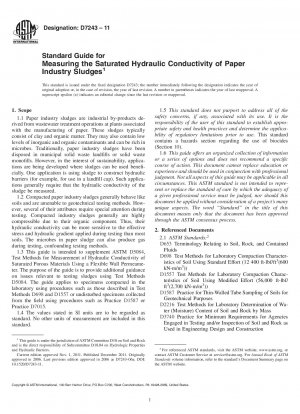ASTM D7243-11
Standard Guide for Measuring the Saturated Hydraulic Conductivity of Paper Industry Sludges
- Standard No.
- ASTM D7243-11
- Release Date
- 2011
- Published By
- American Society for Testing and Materials (ASTM)
- Status
- Replace By
- ASTM D7243-11(2020)
- Latest
- ASTM D7243-11(2020)
- Scope
This guide is intended to supplement the methods and procedures described in Test Methods D 5084
. When following the recommendations in this guide to test paper sludges, all assumptions and limitations described in Test Methods D 5084 apply. This guide only applies to hydraulic conductivity tests on paper industry sludges where one-dimensional laminar flow of water is imposed using a flexible-wall permeameter.
The hydraulic conductivity of sludges, and other porous materials, generally decreases as the degree of water saturation decreases. This guide applies only to water-saturated sludge containing negligible amounts of gas.
This guide applies only to permeation of paper industry sludges with water. Information on testing porous materials with liquids other than water can be found in Test Method D 7100
. The hydraulic conductivity of paper sludge measured in the laboratory following Test Methods D 5084
and the recommendations in this guide may or may not be comparable to the hydraulic conductivity of in-place sludge. The issue has not been fully investigated. Therefore, the results should be applied to field situations with caution and by qualified personnel. Note 18212;The quality of the result produced when using the recommendations in this guide depends on the competence of the personnel performing the testing and the suitability of the equipment and facilities that are employed. Agencies that meet the criteria of Practice D 3740
are generally considered capable of competent and objective testing, sampling, inspection, etc. Users of this guide are cautioned that compliance with Practice D 3740 does not in itself ensure reliable results. Reliable results depend on many factors; Practice D 3740 provides a means of evaluating some of those factors. 1.1 Paper industry sludges are industrial by-products derived from wastewater treatment operations at plants associated with the manufacturing of paper. These sludges typically consist of clay and organic matter. They may also contain low levels of inorganic and organic contaminants and can be rich in microbes. Traditionally, paper industry sludges have been disposed in municipal solid waste landfills or solid waste monofills. However, in the interest of sustainability, applications are being developed where sludges can be used beneficially. One application is using sludge to construct hydraulic barriers (for example, for use in a landfill cap). Such applications generally require that the hydraulic conductivity of the sludge be measured.
1.2 Compacted paper industry sludges generally behave like soils and are amenable to geotechnical testing methods. However, several of their attributes require special attention during testing. Compacted industry sludges generally are highly compressible due to their organic component. Thus, their hydraulic conductivity can be more sensitive to the effective stress and hydraulic gradient applied during testing than most soils. The microbes in paper sludge can also produce gas during testing, confounding testing methods.
1.3 This guide is intended to supplement ASTM D 5084, Test Methods for Measurement of Hydraulic Conductivity of Saturated Porous Materials Using a Flexible Wall Permeameter. The purpose of the guide is to provide additional guidance on issues relevant to testing sludges using Test Methods D 5084. The guide applies to specimens compacted in the laboratory using procedures such as those described in Test Methods D 698 and D 1557 or undisturbed specimens collected from the field using procedures such as Practice D 1587 or Practice D 7015.
1.4 This standard does not purport to address all of the safety concern......
ASTM D7243-11 Referenced Document
- ASTM D1557 Standard Test Methods for Laboratory Compaction Characteristics of Soil Using Modified Effort (56,000 ft-lbf/ft3 (2,700 kN-m/m3))
- ASTM D1587 Standard Practice for Thin-Walled Tube Sampling of Soils for Geotechnical Purposes
- ASTM D2216 Standard Test Method for Laboratory Determination of Water (Moisture) Content of Soil and Rock by Mass
- ASTM D3740 Standard Practice for Minimum Requirements for Agencies Engaged in the Testing and/or Inspection of Soil and Rock as Used in Engineering Design and Construction
- ASTM D5084 Standard Test Methods for Measurement of Hydraulic Conductivity of Saturated Porous Materials Using a Flexible Wall Permeameter
- ASTM D653 Standard Terminology Relating to Soil, Rock, and Contained Fluids
- ASTM D698 Standard Test Methods for Laboratory Compaction Characteristics of Soil Using Standard Effort (12 400 ft-lbf/ft3 (600 kN-m/m3))*, 2024-04-19 Update
- ASTM D7015 Standard Practices for Obtaining Intact Block lpar;Cubical and Cylindricalrpar; Samples of Soils*, 2024-04-19 Update
- ASTM D7100 Standard Test Method for Hydraulic Conductivity Compatibility Testing of Soils with Aqueous Solutions
ASTM D7243-11 history
- 2020 ASTM D7243-11(2020) Standard Guide for Measuring the Saturated Hydraulic Conductivity of Paper Industry Sludges
- 2011 ASTM D7243-11 Standard Guide for Measuring the Saturated Hydraulic Conductivity of Paper Industry Sludges
- 2006 ASTM D7243-06a Standard Guide for Measuring the Saturated Hydraulic Conductivity of Paper Industry Sludges
- 2006 ASTM D7243-06 Standard Guide for Measuring the Saturated Hydraulic Conductivity of Paper Industry Sludges
